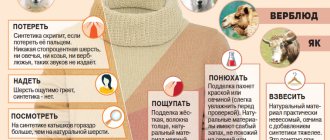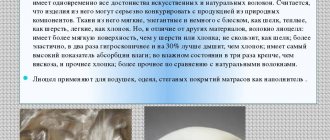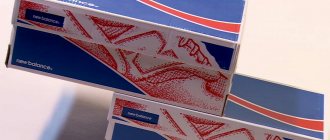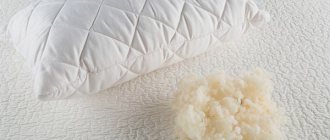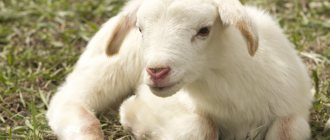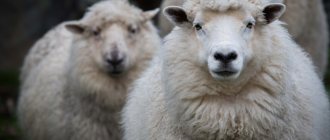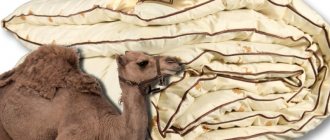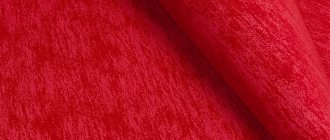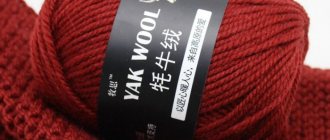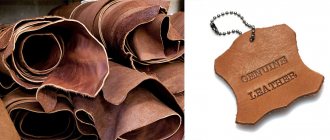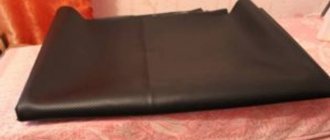There are most hats, blankets, and socks made of sheep wool on the market, and they are inexpensive. Apparently, because of this, buyers are not so careful when choosing a product. Fraudsters take advantage of this and counterfeit “sheep” no less actively than the more expensive camel wool, yak down and cashmere.
“No more than 5% of synthetics in wool yarn is allowed,” says Natalya Konyukova , deputy general director of the cloth factory, “otherwise the yarn is considered half-woolen. There are few pills on woolen products, but synthetics roll up very much. Wool provides noticeable warmth - just wrap your hand in the cloth. But the most effective test is with fire. Set fire to several fibers of the product. Natural sheep’s wool smells like burnt horn and doesn’t melt.”
Question and answer Really warm. What fillers and membranes are used in down jackets? In turn, sheep wool is often used to counterfeit higher quality and more expensive camel wool, yak down and cashmere.
Chinese “masters” were the first to establish such production, then their recipe was adopted in Mongolia and Russia. It is simple: 60% of coarse sheep wool is taken from about 40% of synthetics (acrylic or viscose), to which 2-3% of the raw materials they are trying to depict are mixed.
The fake is then painted in a “natural color”. The colors of cashmere are white, beige-cream, warm gray and café au lait, yak down is gray, light brown (“cappuccino”) and dark brown, camel hair is sandy beige, beige cream, light chocolate. .
Wild treasure of Mongolia
“Cashmere, camel and yak down are not really wool,” says Odonchimeg Yongdon , an entrepreneur from Mongolia. — This is the undercoat of a camel, yak or goat (cashmere). The materials are unique - there is nothing lighter or warmer. Camel also contains lanolin, which penetrates the human body through the pores of the skin and has a beneficial effect on health. All materials are very delicate - if you walk on the floor in camel socks, they will wear out in a week. But if the clothes are not subject to friction, they can be worn for years.”
Article on the topic
Clothes for health: which fabrics are good to wear and which ones are the opposite
The listed types of wool are the most expensive; Let's say a cashmere cardigan is unlikely to be cheaper than 15-20 thousand rubles. “The price of the product, by the way, sometimes helps to identify a fake,” notes Odonchimeg. “For example, socks made of camel wool cannot cost 250-300 rubles - their retail price is at least 600.”
The main reason for the high cost is the difficulty of obtaining raw materials. Camels, goats and yaks are semi-wild animals. To comb out the fluff, you must first catch them. And if it is not difficult to catch and tie a goat, a camel is more difficult, but possible, then no one can hold a yak. And the production time is also sharply limited.
Properties of cashmere
- Airiness and light weight. A real cashmere shawl made from mountain goat down can be pulled through a ring;
- Soft, thin and elastic threads;
- Retains and does not release dry heat well;
- Does not cause allergies or negative reactions, does not contribute to the appearance and reproduction of dust mites;
- Sufficiently high strength and wear resistance;
- Pellets form only after prolonged and regular use;
- Has a healing effect. Improves joint condition and spinal health;
- Contains wax-lanolin, due to which cashmere clothing makes the skin soft, smooth and elastic;
- Soothes and performs micro-massage functions;
- Versatility. Suitable for sewing children's and adult items, various types of clothing and other products.
Sheep under camel
“With a guarantee” it is much more difficult to distinguish cheap wool from expensive undercoat than sheepskin from synthetics, warns a Mongolian expert. But it is possible.
Article on the topic
How to choose thermal underwear? “First of all, in terms of texture: the fake is harder and rougher to the touch, the fibers are thicker,” explains Odonchimeg. “It also squeaks if you rub one part of the product against another. “Sheep” is heavier. For example, fake leggings will slip under their own weight, but camel and yak leggings will not. Another sign is the smell. Any wet fake just reeks of sheep. Natural camel, yak down and cashmere have a faint odor, completely unlike sheep.”
“There are peculiar Russian fakes,” the expert added, “when, for example, a coat whose fabric contains no more than 10% cashmere (and this is indicated on the label) is called cashmere. The price is high, like a cashmere product. It is not right. I believe that if they say “camel”, “yak”, “cashmere”, then the content of these materials should be one hundred percent.”
Production and use
To obtain natural cashmere, the undercoat of mountain goats is hand combed with a comb. This is done only once a year, in the spring, when the animals moult. The collected wool is cleaned and then sorted by thickness and fiber length. So, from one goat they get 100-150 grams of fluff. For example, to sew a cashmere coat, the down of over ten animals is required.
The resulting fluff is used to make thin and smooth yarn, which is then woven and dyed by hand. The fabric is then used to make various clothes for adults and children. The most popular are coats, sweaters and cardigans, sweaters, skirts and dresses made of cashmere. Carpets, shawls and hats are also made from the material. The material is suitable even for newborns, because it is soft and warm, does not prick and does not cause allergies.
Undyed natural cashmere has a white, beige, gray or black color with a slight haze. To obtain a bright and rich color, the fabric is made with the addition of wool and silk fibers. In addition, silk gives the products additional strength and an elegant shine.
Cashmere fabric should not contain more than 30% silk. For the cheaper category of “must have” items, up to 10% synthetic fibers are used. If the synthetic content is higher, it is already an artificial material. But it is better to choose material with natural hand-painting, where natural additives, herbal and plant juices are used.
Technical properties of sheep wool
The yield of pure wool is determined by expert analysis, laboratory methods, or production control washing of a batch of wool.
An expert method of determining the yield of pure fiber, i.e. organoleptically, without the use of any instruments, but with the help of the senses and existing experience, is called wool taxation. In the practice of work of procurers and procurement points, the expert method of determining yield (taxat) is the most common.
In the expert method of determining the output of pure fiber, the wool receiver takes into account the reasons on which the output of wool depends, an analysis of the output of pure fiber of individual farms in the area of activity of a given procurement office is carried out using copies of receipt receipts, feeding, maintenance, and climatic influences on the wool of sheep are taken into account. Manufacturers should be guided by the results of washing wool batches with wool washers and compare their expert assessment of the yield of clean fiber with them. The deviation in the yield of pure fiber is allowed within the guidelines of ±1%.
In the expert method of determining the yield of pure wool, the degree and nature of mineral impurities, their penetration into the staple, the braid, the degree of fat content, the presence of plant debris, the contamination of individual parts of the fleece, the degree of humidity, length, fineness, density and density of the fibers in the fleece are taken into account.
The laboratory method for determining the yield of pure fiber is carried out by the wool control laboratories of district procurement offices in accordance with the current guidelines for determining the quality of unwashed wool, approved by the State Inspectorate for the Quality of Agricultural Products and Raw Materials. The yield of clean wool is determined separately for the assortment of classified wool obtained after control classification.
The selection of initial samples for laboratory analysis is carried out during the control classification of wool. Bales of wool are weighed before control classification. The selection of bales is carried out according to the marking of the sender at the time of quantitative receipt of the incoming batch of wool by selecting bales of each assortment, followed by the selection of every fifth bale (for fine and semi-fine) or tenth (for semi-coarse, coarse and other types of wool).
By assortment of wool we mean wool of the same type, i.e. wool of the same type, name (based on breed), class, subclass, color, condition of contamination and defects. These indicators are determined in accordance with standards and specifications. The total weight of the initial sample must be at least 1% of the weight of the wool assortment, but not less than 2 kg and not more than 10 kg. To select the initial sample, wool of a given assortment is spread out in an even layer in the form of a bed. Then, scraps of wool weighing approximately 10-20 g are taken from different places in such a way that scraps from the entire mass of wool are included in the sample. For selection, a stencil mesh with round or square cells with a diameter or side of no more than 15 cm is used. Pieces of wool are carefully taken from each cell of the mesh in order to preserve all the mineral and vegetable impurities of the wool in the sample.
The initial sample is taken from correctly graded wool. There should be no inferior grades in rune wool. If the amount of wool of one type during control classification exceeds 1 ton, then two initial samples are selected. The final tax in this case is calculated as the arithmetic average of the results of two samples. The original sample is placed in a special box or bag and immediately weighed to the nearest 5 g.
Together with the sample, a passport signed by the sender and receiver is included, and also indicates: the name of the region, procurement office, wool assortment, name of the farm that supplied the wool, net weight of the wool from which the sample is taken, weight of the original sample, batch number, date of sampling, weight net assortment submitted for classification (when reweighed before control classification).
If the wool is felted, heavily clogged, dusty and sandy at 3/4 of the height of the staple, then the initial sample is selected in this way: from the wool assortment, every tenth fleece is set aside during the classification process without selection; from the first ten selected runes one fleece of average quality is selected, from the second ten in the same order another fleece is selected, etc. throughout the entire assortment. The weight of the selected runes should be about 1% of the assortment weight, but not less than 8 kg. The rune is carefully laid one on top of the other, first with the neck part, then the tail part in one direction, then all the rune is torn into four approximately equal parts in area - along the back and across it. One fourth of the rune without choice, with a fourth of the dropped litter added to it, serves as the initial sample.
The selection of average samples is made from the original one. It is passed through a scutching machine (at least twice) to mix, homogenize the wool, and also remove foreign impurities. From the scutching machine, the original sample is collected into a box, including the scraps stuck in the machine. In the absence of a scutching machine, the original sample is averaged by hand.
The tattered wool is spread on the table in an even layer, mixed again by hand, then a stencil mesh is applied and four average samples weighing 200 g each are taken from each cell in separate scraps of 5-10 g: the main one, a parallel one and two control ones (one of them is sometimes called inspector ).
These samples are immediately weighed on technical scales with an accuracy of 0.1 g. The remainder of the original sample is also weighed and stored until the parties sign the test results.
The main and parallel samples are sent for analysis of the yield of pure fiber, while the control samples are wrapped in thick paper, onto which a label with passport data is pasted, sealed and signed on both sides, and stored for two months.
Washing of medium samples is carried out according to the regime. The main and parallel samples are each separately soaked in a basin in specially prepared or used detergent solutions at a temperature of 38-40° for at least 30 minutes. The soaking solution should contain 1 g of soda per 1 liter of water. Locking of lower grades and warped wool is carried out for no more than 4 hours.
After soaking, the sample is squeezed out by hand or with rollers. After soaking, the solution is filtered through a mesh basket in the tank, adding the scraps of wool that have separated from it to the sample.
Washing followed by rinsing is carried out in five tanks with a capacity of 30 liters each. For washing, take 3 g of 40% laundry soap and 3 g of soda ash per 1 liter of water. For coarse wool, the amount of reagents is reduced to 2 g of soap and 2 g of soda. For heavily soiled, dirty, very greasy wool, take up to 4 g of soda and soap per 1 liter of water.
Hard water is softened in separate vats with trisodium phosphate at the rate of 30-35 mg for each degree of hardness per 1 liter of water. Trisodium phosphate is first dissolved in water at a temperature of 35° and softened water is used after 20-30 minutes.
In table 14 shows the washing mode for average wool samples in laboratory conditions.
Table 14. Washing mode for medium wool samples
| Washing tank numbers | Amount of cleaning solution in the tank, l. | Concentration of washing solutions per 1 liter of water, g | Temperature of solutions, ° | Washing time, min | |
| soap (40%) | soda | ||||
| 1 | 15 | 3 | 3 | 40-45 | 5-6 |
| 2 | 15 | 3 | 3 | 48-50 | 5-6 |
| 3 | 15 | 3 | 3 | 48-50 | 5-6 |
| 4 | 30 | Pure water | 38-40 | 5-6 | |
| 5 | 30 | Same | 20-25 | 5-6 | |
The main sample and then the parallel sample are washed in this mode. When washing, plant debris is removed and pieces of base contaminants are separated.
After washing the four middle samples, the solutions in the first two tanks are replaced. The washing of the next four samples begins with the third tank, which becomes the first for these samples. In the fourth and fifth tanks, clean water for rinsing is changed after 8 samples.
Soaking, washing, and rinsing of medium samples should be carried out sequentially, for no more than 4 hours. After this, the washed samples are dried in a large drying cabinet, and then conditioned in conditioning apparatus at a temperature of 105-110 °.
Most laboratories, instead of air conditioning, use hydraulic devices of various brands: GPO-1 (vertical), GPOSH-2, GPOSH-3, GPOSH-2M (horizontal).
The GPOSH-2M hydraulic device makes it possible to quickly determine the constant dry weight of wool from a washed sample (Fig. 14). When working on it, the washed sample is placed in the sleeve of the device, slightly compacting the sample with your hands and making sure that all the wool is placed in the sleeve. The sample is then compressed in the sleeve until the instrument pressure gauge needle reaches a pressure of 200 kg/cm2. This pressure is maintained for 1 min. Then the pressure is removed, the sample is removed from the sleeve and immediately weighed on a technical scale with an accuracy of 0.1 g.
Rice. 14. Hydraulic device GPOSH-2M: 1 - cover; 2 - sleeve; 3 — oil tank; 4 - plug; 5 — handle; 6 - splines; 7 - cylinder; 8 - pressure gauge; 9 — bypass valve screw; 10 - oil pump; 11 - base; 12 - glass.
Semi-automatic hydraulic devices TsS 53A and TsS 53B are widely used in laboratories.
The wool sample, washed and wrung out by hand, is placed in the sleeve of the hydraulic device (Fig. 15).
Rice. 15. Hydraulic device TsS-53A (general view)
The TS 53A device is turned on through a socket and a special starter located on the side wall of the welding cabinet. Then the signal light LS-3 “Cycle ended” lights up. To put the first sleeve into operation, press the KU-1 control button. The signal light LS-1 lights up. This indicates that the oil pressure flowing through the oil lines from the oil tank is created in the first cylinder.
As the pressure in the cylinder increases, the wool sample is compressed between the case cap and the piston, which is forced upward by the pressure.
Having reached operating pressure, the piston stops, and water from the sample gradually flows out through a special tube. At this time, the signal light LS-4 “Pressure switch” lights up, after a minute LS-3 “Cycle ended” lights up. After this, the next washed wool sample is placed in the second sleeve, the KU-2 control button is pressed, and the squeezing process is repeated in the same sequence. After squeezing, the sample is removed from the sleeve and immediately weighed on a technical scale in order to determine the yield of washed wool based on the weight of the wrung sample.
The TsS 53B hydraulic device differs from the TsS 53A in that it has one sleeve, as well as a starter and a pressure gauge located on the top panel of the cabinet.
Hydraulic devices are checked upon receipt from the manufacturer, as well as during the wool harvesting season or in controversial cases. To check the device, ten samples of fine wool are washed and the weight of each sample is determined after squeezing on the device. Each pressed sample is then dried in a conditioning apparatus to a constant dry weight. After this, the sum of the permanent dry weight of ten wool samples obtained during conditioning is divided by the total weight of the same samples after they have been wrung out on the device. For example, the weight of ten fine wool samples after squeezing was 1212.3 g, and the permanent dry weight after conditioning was 860.7 g.
The permanent dry weight coefficient of this wool is equal to
860,7 : 1212,3 = 0,71.
The results obtained are also checked for each individual sample. To do this, the percentage of yield of each sample obtained using a conditioning apparatus is compared with the percentage of yield obtained using a hydraulic device with a coefficient of 0.71.
If coefficient deviations exceed the tolerances of ±0.02 for wool with a yield of up to 50% and ±0.01 for wool with a yield of over 50%, then it is not recommended to use the device. The main documents for laboratory analysis for the yield of pure fiber are: an act for taking wool samples, a certificate of wool quality and an act for submitting samples.
- Back
- Forward
